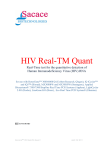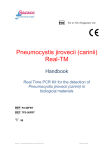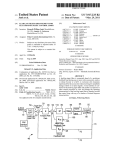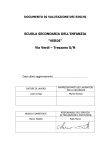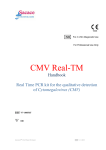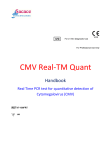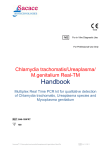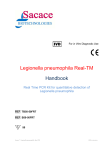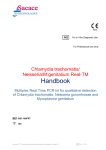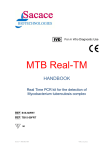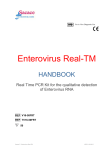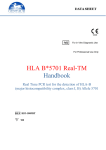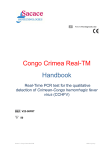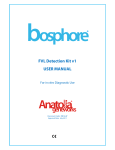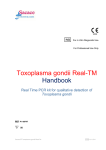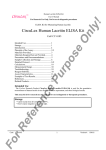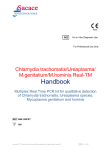Download Rubella Real TM Qual ENG PCR CE
Transcript
For in Vitro Diagnostic Use For Professional Use Only Rubella Real-TM Qual Handbook Real-Time PCR test for qualitative detection of Rubella Virus 50 REF V24-50FRT Sacace™ Rubella Real-TM Qual VER 11.11.2011 NAME RUBELLA Real-TM Qual INTENDED USE RUBELLA Real-TM Qual is a Real-Time test for the qualitative detection of Rubella (Rosolia) Virus RNA in the plasma, serum, umbilical blood, mucosal swabs (nasal, oral), lavages, amniotic liquid, tissue. RUBELLA RNA is extracted from specimens, amplified using RT-amplification and detected using fluorescent reporter dye probes specific for Rubella or Rubella IC. PRINCIPLE OF ASSAY Rubella virus detection by the polymerase chain reaction (PCR) is based on the amplification of the pathogen genome specific region by using specific primers. In realtime PCR, the amplified product is detected using fluorescent dyes. These dyes are linked to oligonucleotide probes that bind specifically to the amplified product. The realtime monitoring of the fluorescence intensities during the real-time PCR allows the detection of accumulating product without re-opening of the reaction tubes after the PCR run. RUBELLA Real-TM Qual PCR kit is a qualitative test that contains the Internal Control (IC), which must be used in the extraction procedure in order to control the extraction process of each individual sample and to identify possible reaction inhibition. RUBELLA Real-TM Qual PCR kit uses “hot-start”, which greatly reduces the frequency of nonspecifically primed reactions. “Hot-start” is guaranteed by separation of nucleotides and Taq-polymerase by using a chemically modified polymerase (TaqF), which is activated by heating at 95 °C for 15 min. MATERIALS PROVIDED Reagent Description Volume, ml Quantity RT-G-mix-2 colorless clear liquid 0.015 1 tube RT-PCR-mix-1-FRT Rubella colorless clear liquid 0.6 1 tube RT-PCR-mix-2-FEP/FRT colorless clear liquid 0.3 1 tube Polymerase (TaqF) colorless clear liquid 0.03 1 tube TM-Revertase (MMlv) colorless clear liquid 0.015 1 tube Positive Control cDNA Rubella / STI (C+) colorless clear liquid 0.1 1 tube RNA-buffer colorless clear liquid 0.6 1 tube straw-colored clear liquid 0.5 2 tubes Positive Control Rubella -rec** colorless clear liquid 0.1 2 tubes Internal Control STI-87-rec (IC)*** colorless clear liquid 0.5 1 tube Negative Control (C–)* * must be used in the isolation procedure as Negative Control of Extraction. ** must be used in the isolation procedure as Positive Control of Extraction (add 10 µl of RNA C+ Rec Fag and 90 µl of Negative Control to the tube labeled PCE ). *** add 10 µl of Internal Control to each sample during the RNA purification procedure directly to the sample/lysis mixture Sacace™ Rubella Real-TM Qual VER 11.11.2011 MATERIALS REQUIRED BUT NOT PROVIDED • RNA extraction kit. • Disposable powder-free gloves and laboratory coat. • Pipettes (adjustable). • Sterile pipette tips with aerosol barriers ( up to 200 µl). • Tube racks. • Vortex mixer. • Desktop centrifuge with a rotor for 2-ml reaction tubes. • PCR box. • Personal thermocycler (for example, RotorGene 6000/Q (Qiagen), iQ5 (Bio-Rad), Mx3005P (Agilent), ABI 7500 (Applied). • Disposable polypropylene microtubes for PCR or PCR-plate. • Refrigerator for 2–8 °C. • Deep-freezer for ≤ –16 °C. • Waste bin for used tips. WARNINGS AND PRECAUTIONS In Vitro Diagnostic Medical Device For In Vitro Diagnostic Use Only 1. Wear disposable gloves, laboratory coats and eye protection when handling specimens and reagents. Thoroughly wash hands afterward. 2. Do not pipette by mouth. 3. Do not eat, drink, smoke, apply cosmetics, or handle contact lenses in laboratory work areas. 4. Do not use a kit after its expiration date. 5. Dispose of all specimens and unused reagents in accordance with local regulations. 6. Biosafety Level 2 should be used for materials that contain or are suspected of containing infectious agents. 7. Clean and disinfect all spills of specimens or reagents using a disinfectant such as 0,5% sodium hypochlorite, or other suitable disinfectant. 8. Avoid contact of specimens and reagents with the skin, eyes and mucous membranes. If these solutions come into contact, rinse immediately with water and seek medical advice immediately. 9. Material Safety Data Sheets (MSDS) are available on request. 10. Use of this product should be limited to personnel trained in the techniques of DNA amplification. 11. PCR reactions are sensitive to contamination. Measures to reduce the risk of contamination in the laboratory include physically separating the activities involved in performing PCR in compliance with good laboratory practice. 12. Workflow in the laboratory must proceed in a uni-directional manner, beginning in the Extraction Area and moving to the Amplification and Detection Area. Do not return samples, equipment and reagents in the area where you performed previous step. Some components of this kit contain sodium azide as a preservative. Do not use metal tubing for reagent transfer. Sampling of biological materials for PCR-analysis, transportation, and storage are described in details in the handbook of the manufacturer. It is recommended that this handbook is read before beginning of the work. Sacace™ Rubella Real-TM Qual VER 11.11.2011 PRODUCT USE LIMITATIONS All reagents may exclusively be used in in vitro diagnostics. Use of this product should be limited to personnel trained in the techniques of DNA amplification (EN375). Strict compliance with the user manual is required for optimal PCR results. Attention should be paid to expiration dates printed on the box and labels of all components. Do not use a kit after its expiration date. QUALITY CONTROL In accordance with Sacace’s ISO 13485-Certified Quality Management System, each lot is tested against predetermined specifications to ensure consistent product quality. STORAGE INSTRUCTIONS All components of the RUBELLA Real-TM Qual PCR kit (except for RT-G-mix-2, RTPCR-mix-1-FRT Rubella virus, RT-PCR-mix-2-FEP/FRT, polymerase (TaqF), and TMRevertase (MMlv)) are to be stored at 2–8 ºC. All components of the RUBELLA Real-TM Qual PCR kit are stable until the expiration date on the label. The shelf life of reagents before and after the first use is the same, unless otherwise stated. RT-G-mix-2, RT-PCR-mix-1-FRT Rubella virus, RT-PCR-mix-2-FEP/FRT, polymerase (TaqF), and TM-Revertase (MMlv) are to be stored at ≤ –16 °C RT-PCR-mix-1-FRT Rubella virus is to be kept away from light. RUBELLA Real-TM Qual PCR kit should be transported at 2–8 °C for no lon ger than 5 days but should be stored at 2-8 and -20°C immediat ely on receipt. STABILITY RUBELLA Real-TM Qual Test is stable up to the expiration date indicated on the kit label. The product will maintain performance through the control date printed on the label. The shelf life of reagents before and after the first use is the same, unless otherwise stated. Exposure to light, heat or humidity may affect the shelf life of some of the kit components and should be avoided. Repeated thawing and freezing of these reagents should be avoided, as this may reduce the sensitivity. Components stored under conditions other than those stated on the labels may not perform properly and may adversely affect the assay results. Sacace™ Rubella Real-TM Qual VER 11.11.2011 SAMPLE COLLECTION, STORAGE AND TRANSPORT RUBELLA Real-TM Qual can analyze RNA extracted from: • Peripheral and umbilical cord blood plasma. Collect blood to a Vacuett tube (lavender cap, 6% EDTA) after overnight fasting or at least 3 h after the patient had a meal. Invert the tube several times to ensure proper mixing of blood with the anticoagulant. Centrifuge the tube with blood at 800–1600 g at room temperature for 20 min. Take 1.0 ml of plasma and transfer it to a sterile 2.0-ml Eppendorf tube. • Saliva. Collect 0.2–1.0 ml of saliva to a 1.5-ml Eppendorf tube. Have the patient to rinse his mouth with water 3 times before sampling saliva. • Oropharyngeal swabs are obtained with a dry cotton probe from the tonsillar area, palatine arches, and posterior oropharyngeal surface. Have a patient to rinse his mouth with water before swabbing. After sampling, the cotton end of the probe should be placed into a sterile tube containing 500 µl of transport medium. Then the probe should be broken off at the score mark and the tube should be tightly closed. • Amniotic fluid should be obtained during amniocentesis by the standard procedure and collected to a sterile Eppendorf tube. Thoroughly resuspend the obtained sample and transfer 1 ml of it to a new sterile tube. Centrifuge the tube at 8,000– 9,000 g for 10 min. Remove the supernatant leaving 200 µl of the fluid over the pellet. Use tips with aerosol barrier. Resuspend the pellet. • Bronchial lavage, nasal wash: centrifuge at 2000 g/min for 10-15 min. If the pellet is not visible add 10 ml of liquid and repeat centrifugation. Remove and discard the supernatant. Resuspend the pellet in 100 µl of Saline water. • Tissue homogenized with mechanical homogenizer and dissolved in PBS sterile Specimens can be stored at +2-8°C for no longer tha n 12 hours, or frozen at -20°C to 80°C. Transportation of clinical specimens must comply with country, federal, state and local regulations for the transport of etiologic agents. RNA ISOLATION The following isolation kits are recommended: ⇒ Ribo-Sorb (Sacace, REF K-2-1) ⇒ Ribo-Virus (Sacace, REF K-2/C) ⇒ DNA/RNA-Prep (Sacace, REF K-2-9); Please carry out the RNA extraction according to the manufacturer’s instructions. During extraction, use the following controls: • Positive Control Rubella virus-rec (Positive Control of Extraction, PCE): add 90 µl of Negative Control (C–) and 10 µl of RUBELLA RNA C+ Rec Fag to the tube labeled PCE; • Negative Control (C–): add 100 µl of Negative Control (C–) to labeled C• Internal Control STI-87-rec (IC): add 10 µl of Internal Control RNA during the RNA isolation procedure directly to the sample/lysis mixture. Sacace™ Rubella Real-TM Qual VER 11.11.2011 REAGENTS PREPARATION (REACTION VOLUME 25 µL): 1. Prepare required quantity of reaction tubes. 2. Prepare for each sample in the new sterile tube Reaction Mix: add 10 µl of RTPCR-mix-1, 5 µl of RT-PCR-mix-2, 0,25 µl of RT-G-mix-2, 0,50 µl of TaqF Polymerase and 0,25 µl of M-MLV Revertase. Vortex thoroughly and centrifuge for 5 sec. This mix must be used immediately. Don’t store the prepared mix! Reagents volume x 1 10,0 5,00 0,25 reaction (µl) 2 N RNA N reactions RT-PCRRT-PCRRT-G1 samples mix-1 mix-2 mix-2 4 6 60 30 1,5 6 8 80 40 2,0 8 10 100 50 2,5 10 12 120 60 3,0 12 14 140 70 3,5 ...58 60 600 300 15,0 1 specimens plus 2 extraction controls (N+2) 2 specimens plus extraction and amplification controls (N+2+2) 0,50 0,25 TaqF Polymerase 3,0 4,0 5,0 6,0 7,0 30,0 M-MLV Revertase 1,5 2,0 2,5 3,0 3,5 15,0 3. Add 15 µl of Reaction Mix into each tube. 4. Add 10 µl of extracted RNA sample to appropriate tubes with Reaction Mix and mix well by pipetting. (Re-centrifuge all the tubes with extracted RNA for 2 min at maximum speed (1200016000 g) and take carefully supernatant. N.B. don’t disturb the pellet, sorbent inhibit reaction!). 5. Prepare for each panel 2 controls: • NCA: add 10 µl of RT-eluent to the tube labeled Negative Control; • C+: add 10 µl of RUBELLA cDNA Pos & IC Pos to the tube labeled Positive Control; The results are interpreted through the presence of crossing of fluorescence curve with the threshold line. Rubella cDNA is detected on the JOE(Yellow)/HEX/Cy3 channel, IC DNA on the FAM (Green) channel Sacace™ Rubella Real-TM Qual VER 11.11.2011 AMPLIFICATION Program the real-time instrument according to manufacturer’s manual. Amplification program for rotor-type instruments1 Step Hold Hold 2 Cycling Cycling2 Temperature, °С 50 95 95 60 72 95 60 72 Time 15 min 15 min 5s 20 s 15 s 5s 20 s 15 s Fluorescence detection – – – – – – FAM/Green, JOE/Yellow Repeats 1 1 5 40 Fluorescence is detected at the 2nd step of Cycling 2 stage (60 °C) in FAM/Green and JOE/Yellow fluorescence channels. Amplification program for plate-and modular type instruments2 Step 1 2 3 4 Temperature, °С 50 °С 95 °С 95 °С 60 °С 72 °С 95 °С 60 °С 72 °С Time 15 min 15 min 5s 20 s 15 s 5s 30 s 15 s Fluorescence detection – – – – – – FAM, HEX/Cy3/Joe Repeats 1 1 5 40 Fluorescence is detected at stage 4 (60 °C) in FAM and HEX fluorescence channels. 1 For example Rotor-Gene™ 6000/Q (Corbett Research, Qiagen) For example, iQ5™ (BioRad); Mx3005P™ (Stratagene), Applied Biosystems® 7500 Real Time PCR (Applera), SmartCycler® (Cepheid) 2 Rotor-type instruments (Rotor-Gene 3000/6000, Rotor-Gene Q, etc.) Settings Calibrate/Gai More Settings/ n Slope Channel Threshold Outlier Dynamic tube Correct Optimisation Removal … FAM/Gre from 3 Fl to 8 0.03 10 % On On Fl en JOE/Yell from 3 Fl to 8 0.03 10 % On On Fl ow Plate-type instruments (iQ5, Mx300P, ABI 7500/7300) Settings Channel Threshold The threshold line should cross only sigmoid curves of signal FAM accumulation of positive samples and should not cross the baseline; HEX/Joe/C otherwise, the threshold level should be raised. Set the threshold at a level where fluorescence curves are linear and do not cross y3 curves of the negative samples. Sacace™ Rubella Real-TM Qual VER 11.11.2011 Sacace™ Rubella Real-TM Qual VER 11.11.2011 DATA ANALYSIS Accumulation of Rubella virus cDNA amplification product is detected in the JOE/Yellow/HEX channel, Internal Control amplification product is detected in the FAM/Green channel. The results are interpreted by the software of the PCR instrument used by the crossing (or not crossing) of the fluorescence curve with the threshold line. The results of analysis are considered reliable only if the results obtained for Positive and Negative Controls of Amplification as well as for the Negative Control of Extraction are correct. Results for controls Control Stage for control NCE PCE NCA C+ RNA extraction RNA extraction RT-PCR RT-PCR Ct in channel JOE/Yellow/HE FAM/Green X ≤ 35 Neg ≤ 35 ≤ 35 Neg Neg ≤ 35 ≤ 35 Interpretation OK OK OK OK 1. The sample is considered positive if its Ct value detected in the JOE/Yellow/HEX channel does not exceed the boundary Ct value (< 40 for clinical samples) and the Ct value detected in the FAM/Green channel does not exceed the value specified for the Internal Control (Ct < 35). The fluorescence curve should have a typical sigmoid shape and cross the threshold line once in the region of significant fluorescence increase. 2. The sample is considered negative if its Ct in the JOE/Yellow/HEX channel is not detected (the fluorescence curve does not cross the threshold line) and the Ct value detected in the FAM/Green channel does not exceed the boundary Ct value specified for the Internal Control (Ct < 35). QUALITY CONTROL PROCEDURE A defined quantity of Internal Control (IC) is introduced into each sample and control at the beginning of sample preparation procedure in order to control the extraction process of each individual sample and to identify possible reaction inhibition. A negative control of extraction (NCE), positive control of extraction (PCE), negative amplification control (NCA), positive amplification control (C+) are required for every run to verify that the specimen preparation, the amplification and the detection steps are performed correctly. If the controls are out of their expected range (see table Results for Controls), all of the specimens and controls from that run must be processed beginning from the sample preparation step. Sacace™ Rubella Real-TM Qual VER 11.11.2011 PERFORMANCE CHARACTERISTICS Analytical specificity The analytical specificity of RUBELLA Real-TM Qual PCR kit is ensured by selection of specific primers and probes as well as stringent reaction conditions. The primers and probes were checked for possible homologies to all sequences published in gene banks by sequence comparison analysis. The clinical specificity of RUBELLA Real-TM Qual PCR kit was confirmed in laboratory clinical tests. Analytical sensitivity The kit RUBELLA Real-TM Qual allows to detect RUBELLA RNA in 100% of the tests with a sensitivity of not less than 400 copies/ml. The claimed analytical features of RUBELLA Real-TM Qual PCR kit are guaranteed only when an additional reagent kit (DNA/RNA-prep or RIBO-sorb or Ribo-Virus) is used. Target region: p150 gene TROUBLESHOOTING The results of analysis are not taken into account in the following cases: 1. If the Ct value of a clinical sample detected in the JOE/Yellow/HEX channel exceeds the boundary Ct value (>37), the result is considered equivocal. It is necessary to repeat the analysis twice. If a reproducible positive Ct value is detected, the sample is considered to be positive. 2. If any Ct value is detected for the Negative Control of Amplification (NCA) in both channels or the Ct value is detected for Negative Control of Extraction (C–) in the JOE/Yellow/HEX channel, this indicates the contamination of reagents or samples. In this case, the results of analysis of all samples are considered invalid. It is necessary to repeat the analysis of all tests and to take measures to detect and eliminate the source of contamination. 3. If the Ct value is absent for the Positive Control of Extraction (PCE), this indicates improper extraction procedure. RNA extraction should be repeated for all samples. 4. If the Ct value is absent for the Positive Control of RT-PCR (C+), this indicates errors in carrying out PCR or an incorrect amplification program. RT-PCR should be repeated for all samples. 5. If the Ct value of a clinical sample is absent or greater than the boundary Ct value (>37) for the JOE/Yellow/HEX channel and the Ct value in the FAM/Green channel is greater than the Ct values specified for the Internal Control (>37), the result is invalid. Analysis of such samples should be repeated starting from the RNA extraction stage. Sacace™ Rubella Real-TM Qual VER 11.11.2011 REFERENCES • Comparison of four methods using throat swabs to confirm rubella virus infection. Zhu Z, Xu W, Abernathy ES, Chen MH, Zheng Q, Wang T, Zhang Z, Li C, Wang C, He W, Zhou S, Icenogle J. J Clin Microbiol. 2007 Sep;45(9):2847-52. Epub 2007 Jun 27 • Application of molecular and serological assays to case based investigations of rubella and congenital rubella syndrome. Jin L, Thomas B. J Med Virol. 2007 Jul;79(7):1017-24. • Improved RT-PCR for diagnosis and epidemiological surveillance of rubella. Cooray S, Warrener L, Jin L. J Clin Virol. 2006 Jan;35(1):73-80. Epub 2005 Jul 12. • PCR for detection of rubella virus RNA in clinical samples. TJ Bosma, KM Corbett, S O'Shea… - Am Soc Microbiol JOURNAL OF CLINICAL MICROBIOLOGY, May 1995, p. 1075–1079 • An RT-PCR assay using oral fluid samples to detect rubella virus genome for epidemiological surveillance. A.J. Vyse, L. Jin. Molecular and Cellular Probes Volume 16, Issue 2, April 2002, Pages 93-97 Sacace™ Rubella Real-TM Qual VER 11.11.2011 KEY TO SYMBOLS USED List Number Caution! Lot Number Contains sufficient for <n> tests For in Vitro Diagnostic Use Version Store at NCA Negative Control of Amplification Manufacturer C– Negative control of Extraction Consult instructions for use C+ Positive Control of Amplification Expiration Date Sacace™ Rubella Real-TM Qual IC Internal Control VER 11.11.2011 *iQ5™ is a registered trademark of Bio-Rad Laboratories * Rotor-Gene™ Technology is a registered trademark of Qiagen * MX3005P® is a registered trademark of Agilent Technologies *ABI® is a registered trademark of Applied Biosystems * LineGeneK® is a registered trademark of Bioer * SmartCycler® is a registered trademark of Cepheid Sacace Biotechnologies Srl via Scalabrini, 44 – 22100 – Como – Italy Tel +390314892927 Fax +390314892926 mail: [email protected] web: www.sacace.com Sacace™ Rubella Real-TM Qual VER 11.11.2011













